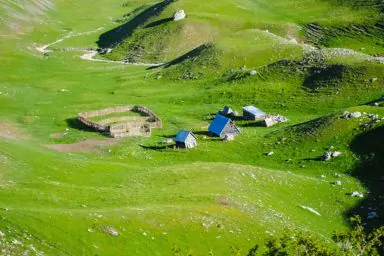Kotor in Montenegro is sometimes called the capital of the Bay of Kotor for a number of reasons. Firstly, because is one of the largest towns here. Secondly, because it defined the fortunes of the entire region for a long time. Thirdly, because it is probably the most interesting and beautiful town in the Bay.
The narrow streets, stone paving, ancient temples and rich history attract hundreds of thousands of people each year.
Kotor guide
Like the other old cities in the Bay Kotor has two parts, an old town and a new town. As you would expect most of the sights are located in the old town. The new town made up of nearby villages that became suburbs; Skolari, Dobrota, Muo and so on. Facilities such as hospitals, schools, markets, shopping centres and sports centres are located here. There is a long quay which runs from the old town and nearly all the way to the Bay. It is a promenade with restaurants, cafes and benches looking out of sea. Near the city walls there is a small port where yachts, boats and even large cruise ships dock.
The old town of Kotor dates back to the VI century B.C. However, its current appearance originates from the XV-XVI centuries when the Republic of Venice controlled the entire Bay. This is the reason why Kotor looks much like Budva and Dubrovnik and all these towns also bear a close resemblance to Venice. After the Venetians came the Austrians, the Russians (for 11 months at the beginning of the XIX century), the French, and finally the Serbs. Despite this Kotor always been an independent trading and cultural centre and continues to be thus today. There are buildings, monuments, walls, and sights still in their original state.
Sights and places of interest
The most notable sight is the fortified wall of Kotor. It is visible even from the approach to the town. It is a massive structure, rising high over a steep mountain slope. The walls encircle the town below and join at the height of 120 m, continuing as a single jagged wall. This wall ends with a huge cascading fortress at 280 m above sea level. The fortress was built during the Venetian reign in the XV and XVI centuries. The walls are 4.5 km long and 0.5 to 20 m thick. 38 cannons were mounted along the wall. When the enemy approached the town Kotor’s defenders rallied at the fortress and started their barrage from above. The city was almost impregnable.
Today the fortress is open for visitors. I have marked the exits at the top of the wall on the map. The wall and the fortress are not used as a museum or a military installation so visitors can explore freely. The ascent from Kotor and the return path including the stops will take about two hours. The minimum amount of time needed to run to the top and back is 40 minutes. You must be extremely fit to undertake this run. If you do not have lots of time you can visit the lower part of the wall. The view of the city and the Bay is also very beautiful.
If you decide to climb the wall note that the pathway involves a bit of a climb, it is not a straightforward hike. Avoid high heels or slip-ons and take some water with you.There are no refreshments available at the top.
What else can you see in the old town?
- The clock tower at Oružja square right beside the entrance to the city.
- It was built at the beginning of the XVII century, it now leans towards the gates slightly. Choose a viewing point and try to align it with the other buildings.
- Church of St. Trifon.
- Relics of this third-century saint are stored here. The church is also a museum (entrance fee is about €2). It is interesting particularly the reliquary on the second floor. From there you can go onto the balcony between the bell towers. Avoid closed doors there are CCTV cameras everywhere the attendants can be rather strict.
- St. Luke’s church.
- A small twelfth-century temple which has a very interesting story in that the entire floor is made from the tombstones of more than 3,000 citizens of Kotor. Be sure to find the priest, father Milenko, and ask him to tell you about this church. He is a very pleasant man and meeting him will be memorable. You can find him in the church or at the nearby larger temple of St. Nicholas, but no later than 2pm.
- Church of Blazena Ozana and the adjacent square.
- The square has an unofficial name which is cat square, you will see why. On the doors of the church there are mages of St. Ozana’s life. Her relics are displayed at the church in St. Trifon.
- The three gates of the town.
- Each gate is unique. The main gates by the sea have a bas relief and a port in the stone above it. In the river gates it is the remains of a river power station. In the south gates (at the Budva side), it is a non-working drawbridge.
There is even more than the old town has to offer. First, buy a guide around old Kotor and spend a few unforgettable hours here. There are many restaurants and cafes on our map that will make your visit even more enjoyable.
Make sure to take a look at old Kotor through a 3D satellite view. There are many interesting buildings and it is beautiful.
Shopping in Kotor

If you like shopping Kotor has a fair bit to offer. Most ground floors of buildings are occupied by shops and boutiques. A larger shopping centre, Kamelia, is located near the old town (see map). There is also a market. In the morning you can buy fruit, vegetables, homemade cheese, meat, freshly caught fish and so on. In the evening the same stalls sell gifts and jewelry.
There is a mountain path beyond old Kotor if you like an adventure. It is the old road from Kotor to Cetinje. The beginning of the path is marked on the map, do take care on the path.
If you like clubs Maximus in the old part of the town. It is very popular with the locals, Fatboy Slim once came here. There is also a local branch of the Chinese Pilot Zhao Da.




















